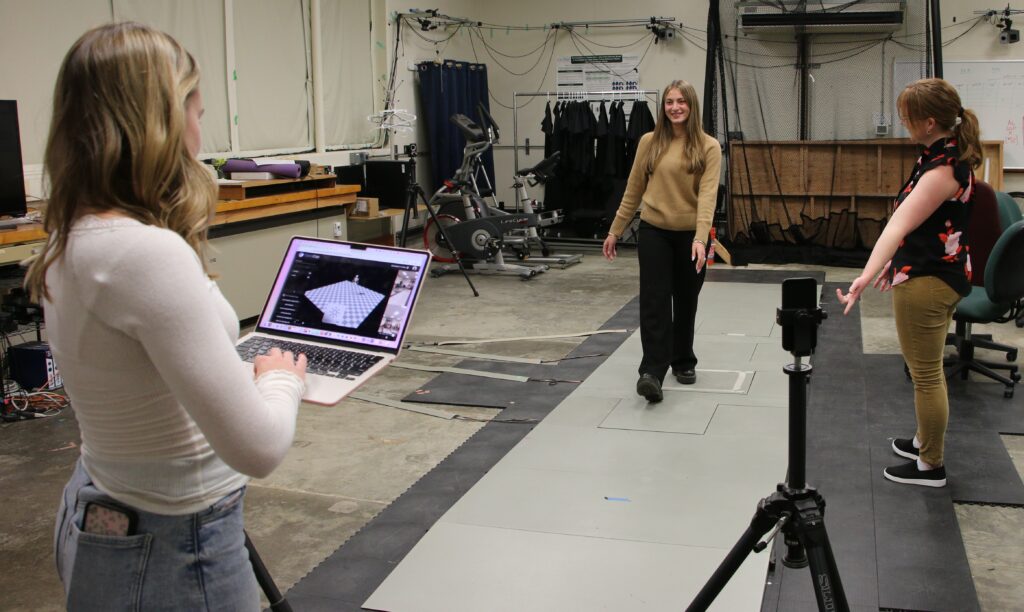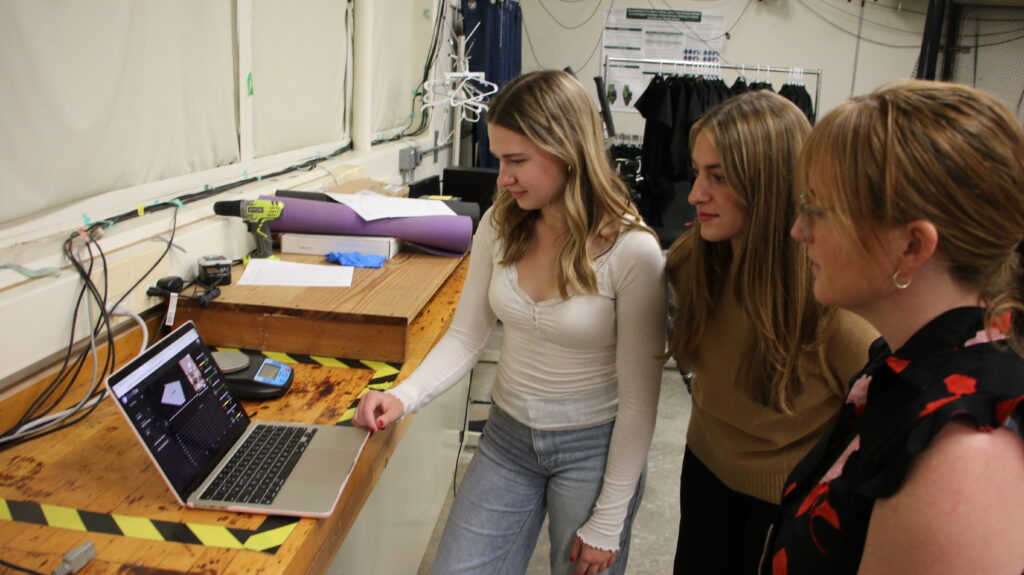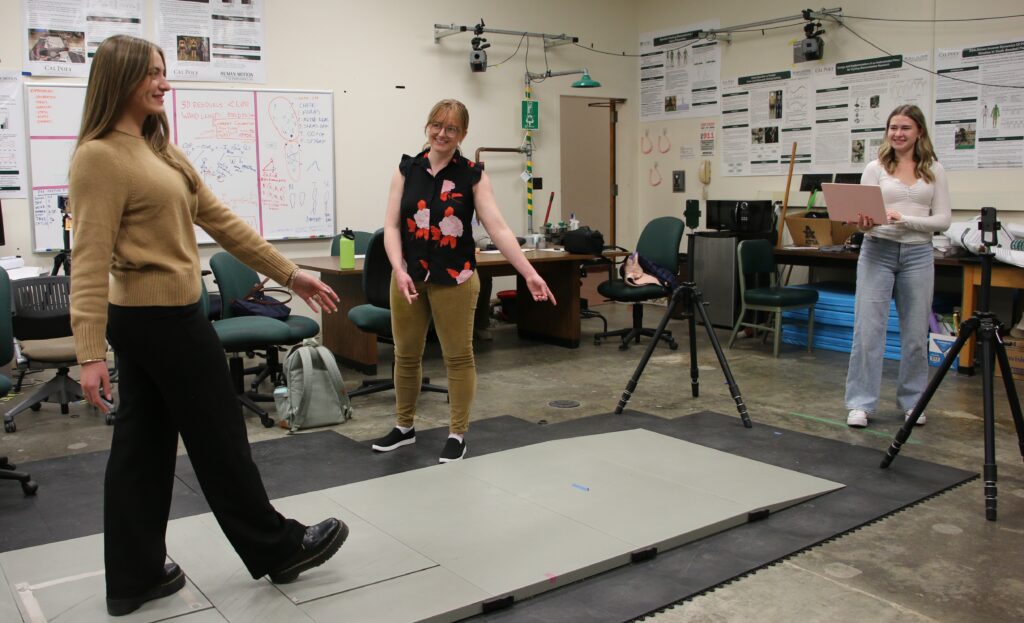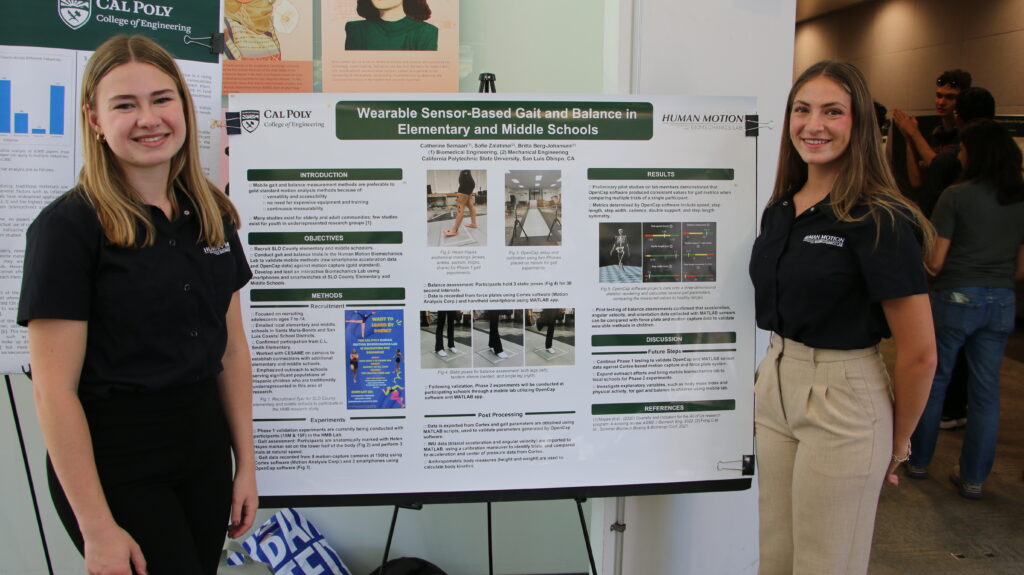Science in Motion: Making Biomechanics Accessible for All Ages

As a new mother and the director of Cal Poly’s Mobile Biomechanics Lab, Professor Britta Berg-Johansen sees the value of movement through a fresh perspective.
“Gait and balance are such important metrics. They can tell us so much about long-term health,” she said. But what excites her most isn’t just the science — it’s the chance to bring this knowledge directly to kids in local classrooms.
The new project, led by Berg-Johansen alongside third-year engineering students Sofie Zalatimo and Catherine Semaan, combines interactive lessons with data-driven research. Using just a smartphone, Zalatimo and Semaan will study how younger students move, tracking metrics like gait and balance to uncover insights that could help predict musculoskeletal issues such as osteoarthritis.
For younger students, these sessions offer a chance to explore how their bodies work in a fun and engaging way. Through a combination of physical activities and real-world data collection, the project makes science both personal and practical.

At its core, the initiative is about inclusivity. By bringing biomechanics to local schools, the team is expanding access to immersive learning and engaging underrepresented communities to ensure all children feel included in science.
“We want to reach as many kids as possible, not just those with the resources to get to a lab,” Berg-Johansen said. “Transportation can be a barrier, and expanding representation is essential to giving more children access to opportunities like this.”
* * *
The research featured in this project is rooted in Cal Poly’s Mobile Biomechanics Lab, a space dedicated to developing practical, mobile methods for studying human movement.
Led by Berg-Johansen, the lab was recently renamed to better reflect its focus on mobile research methods. “We wanted a name that fits what we’re doing — bringing biomechanics into the real world, outside traditional lab settings,” she said.
The lab operates as a collaborative hub, connecting a diverse team of undergraduate and graduate researchers. Guided by faculty experts from biomedical and mechanical engineering, kinesiology and statistics, the team tackles a variety of research projects focused on making biomechanics more widely available.
Traditionally, motion is captured in biomechanics labs using software like Cortex, which tracks reflective markers placed on a subject’s body with specialized cameras. While precise, this system requires a controlled lab environment, making it difficult to use in real-world applications.
To address these challenges, the team is turning to OpenCap, a smartphone-based tool developed by Stanford researchers. OpenCap captures movement using video from two smartphones, allowing biomechanics research beyond the lab. This project will also examine how well OpenCap works with younger children, as research in this age group has been limited.
Semaan saw OpenCap’s potential firsthand when she danced in front of the cameras and watched her skeleton mimic her movements on screen.
“It was surreal — you could see the skeleton dancing along with me,” Semaan said, capturing the tool’s ability to inspire curiosity in young students. “It’s a great way to help kids learn about their bodies and see how movement connects to their health in a way that’s engaging and easy to understand.”
* * *
Semaan and Zalatimo, both members of the Mobile Biomechanics Lab, were drawn to Berg-Johansen’s project for compelling reasons.
For Zalatimo, a mechanical engineering major from Mountain View, California, biomechanics was a new field. However, as a dancer with Cal Poly’s Orchesis Dance Company, she often thinks about force and acceleration — concepts that align naturally with the study of human movement. Semaan, a biomedical engineering major from Downey, California, felt a different kind of connection. Fluent in Spanish, she grew up in a majority Hispanic community and sees this project as an opportunity to foster a more inclusive environment for all students.
“I feel connected personally to the project,” Semaan said. “There’s a place for you even if you don’t speak English.”

Zalatimo and Semaan first connected through the Society of Women Engineers, bonding over their shared passion for outreach. Their dedication to community engagement made them ideal candidates for Berg-Johansen’s initiative, which was launched through the Summer Undergraduate Research Program.
The team is partnering with local schools to introduce students to biomechanics through hands-on activities that highlight the importance of movement and health.
“We want to get kids excited about biomechanics, and in the process, they’ll provide us with valuable data,” Berg-Johansen said.
The data collected will refine the Mobile Biomechanics Lab’s methods for measuring balance and gait using smartphones and inform more inclusive research practices. These advancements will also enhance educational biomechanics lessons and support future studies, such as exploring how body mass index (BMI) affects children’s movement and balance.
“Our classes move so fast, but this project lets me slow down and apply what I’ve learned to real-life research,” Semaan said. “I came to this project fresh out of Engineering Dynamics, and now I’m actually applying those equations.”
For Zalatimo, the most rewarding aspect has been seeing the broader impact of engineering. “I’ve seen how much engineering can positively affect entire communities,” she said. “It’s made me feel more confident in my path as an engineer.”
Berg-Johansen finds it fulfilling to watch her students take ownership of the project. “Both Sofie and Catherine are so self-motivated — it’s inspiring to watch them take on a project like this and truly run with it.”
As a new mom, the project carries even deeper meaning for her. “I did a lot of science education during grad school, but I haven’t yet had the chance to work with kids in my faculty role at Cal Poly,” she said. “Now, as a parent, it’s even more meaningful to spark curiosity in young students and show them how science connects to their lives.”

Support the Future of Mobile Biomechanics
Help bring biomechanics to life for students of all ages. By supporting Cal Poly’s Mobile Biomechanics Lab, you’re empowering the next generation of engineers to design, lead and build a healthier, more accessible future. Advance the science of movement together — make your gift today!
